2011年ATA妊娠和产后甲状腺疾病诊疗指南(中英文对照版)
- 格式:doc
- 大小:151.50 KB
- 文档页数:19

建议1:临床表现为甲状腺功能亢进症而不能诊断为Graves’病时应进行放射碘摄取检查,出现甲状腺结节时应行甲状腺扫描。
1/+建议2:β受体阻滞剂应该使用于那些有甲状腺功能亢进症状的年长患者、其他静息心率超过90bpm或合并心血管疾病的患者。
1/++建议3:β受体阻滞剂在所有甲状腺功能亢进症状患者中使用。
1/+ 建议4:显性Graves’甲状腺功能亢进症患者是否需以下模式的治疗:131I治疗, 抗甲状腺药物或甲状腺切除术?1/++建议5:那些Graves’病患者因甲状腺功能亢进而令并发症的风险增加时(如:临床症状极端恶化或游离T4达到正常高限的2-3倍的),在放射碘治疗前需使用β受体阻滞剂。
1/+建议6:那些Graves’病患者因甲状腺功能亢进而令并发症的风险增加时(如:临床症状极端恶化或游离T4达到正常高限的2-3倍的),在放射碘治疗前需使用甲巯咪唑。
2/+建议7:在放射碘治疗前对于并存病的药物治疗需优化。
1/+建议8:Graves’病的放射碘治疗应足量(经典剂量为10-15 mCi)单次进行。
1/++建议9:在生育年龄的妇女在放射碘治疗前48小时内应进行妊娠试验,医生应掌握该试验的结果且明确为阴性后方可进行放射碘治疗。
1/+建议10:实施放射碘治疗的医生在治疗过程中应提供关于放射安全防范的书面忠告,如果患者不能遵循该安全防范应选择其他治疗方式。
1/+建议11:在放射碘治疗后1-2月内的随访应包括游离T4和总T3的评估,如患者仍处于甲状腺功能亢进,生化检查应该在以后的随访中以4-6周的间隔进行监测。
1/+建议12:Graves’病131I治疗后6个月持续甲状腺功能亢进或在治疗后3个月治疗处于最低限度,建议重复131I治疗。
2/+建议13:Grave s’病的ATD治疗中应选用甲巯咪唑,除了在妊娠前3个月、甲状腺危象、对甲巯咪唑治疗反应小且拒绝行放射碘或手术治疗的患者应考虑使用丙基硫氧嘧啶。
1/++建议14:需告知患者抗甲状腺药物的副反应,而出现以下情况需立即告知医师:痒疹,黄疸,白陶土样便或尿色加深,关节痛,腹痛,恶心,疲乏,发热和咽炎。
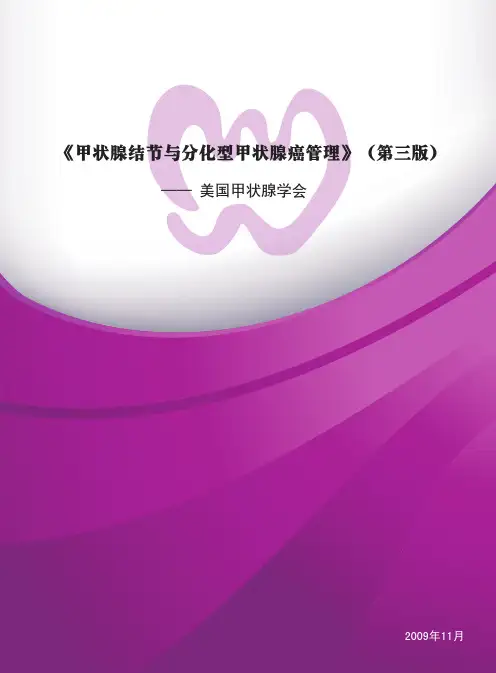
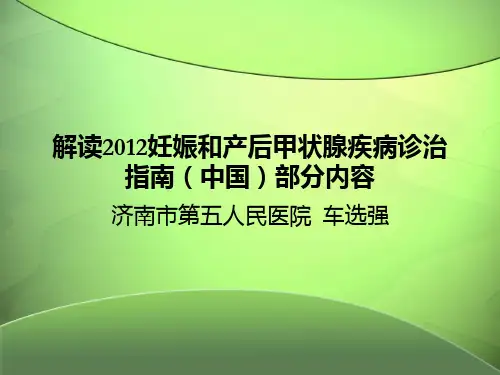
解读2012妊娠和产后甲状腺疾病诊治指南(中国)部分内容济南市第五人民医院车选强主要内容•一指南大体简介•二妊娠期甲状腺相关指标参考值•三临床甲状腺功能减退症•四亚临床甲状腺功能减退症•五单纯低甲状腺素血症•六甲状腺自身抗体阳性•七妊娠期甲状腺毒症一指南大体简介• 1. 主要依据:2011年ATA妊娠及产后甲状腺疾病诊治指南• 2.根据5个强度分级推荐了11项内容57条。
5个强度:A 强力推荐,证据肯定,利大于弊B 推荐,有很好根据,利大于弊C 不做常规推荐利弊接近D 反对推荐证据不够或利小于弊I 缺乏证据,或证据质量差,或证据自相矛盾,无法判断利弊二妊娠期甲状腺相关指标参考值• 1.妊娠期甲状腺相关激素和甲状腺自身抗体有哪些变化?甲状腺素结合球蛋白(TBG)从妊娠6~8周开始增加,20周达到顶峰,一直持续到分娩。
一般较基础值增加2-3倍。
TBG增加必然带来TT4浓度增加,指标不用TT4;绒毛膜促性腺激素(hCG)增加,通常在8~10周达到高峰,hCG有模拟TSH相似作用,引起hcG相关性甲亢,FT4增高。
抑制TSH分泌,使血清TSH水平降低20%~30% 。
TSH水平降低发生在妊娠8~14周,妊娠10~12周是下降的最低点。
妊娠T1期血清FT4水平较非妊娠时升高10~15%。
因为母体对胎儿的免疫妥协作用,甲状腺自身抗体在妊娠后滴度逐渐下降,妊娠20~30周下降至最低滴度,降低幅度为50%左右。
分娩后,甲状腺抗体滴度回升,产后6个月恢复到妊娠前水平。
2 什么是妊娠期特异的血清甲状腺指标参考值?妊娠期甲状腺激素代谢改变势必带来血清甲状腺指标参考值的变化,所以需要建立妊娠期特异的血清甲状腺指标参考范围(简称妊娠期参考值)。
妊娠期参考值分为两类,一类是本医院或者地区建立的妊娠期参考值,另一类是指南推荐的参考值。
例如,2011年ATA指南首次提出妊娠三期特异的TSH参考值,即T1期0.1~2.5 mIU/L;T2期0.2~3.0 mIU/L;T3期0.3~3.0 mIU/L。

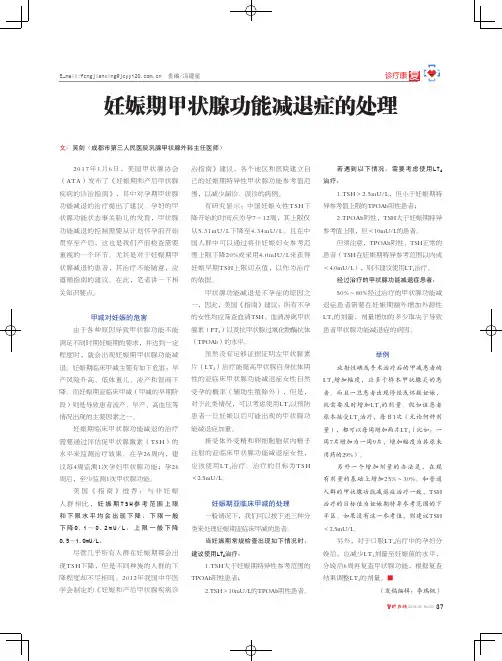
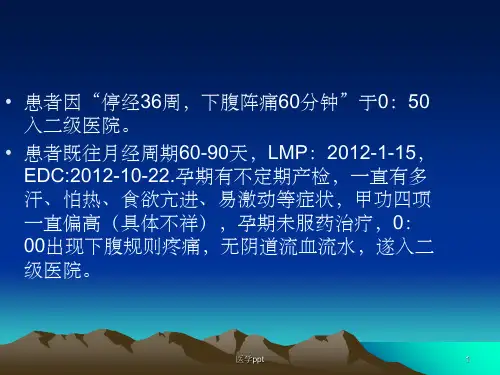
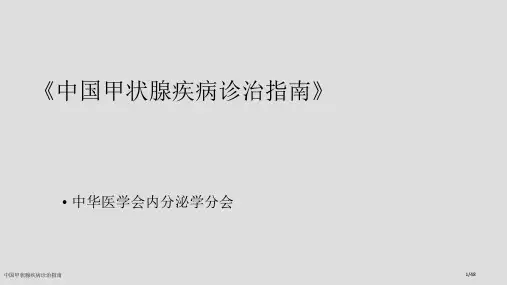

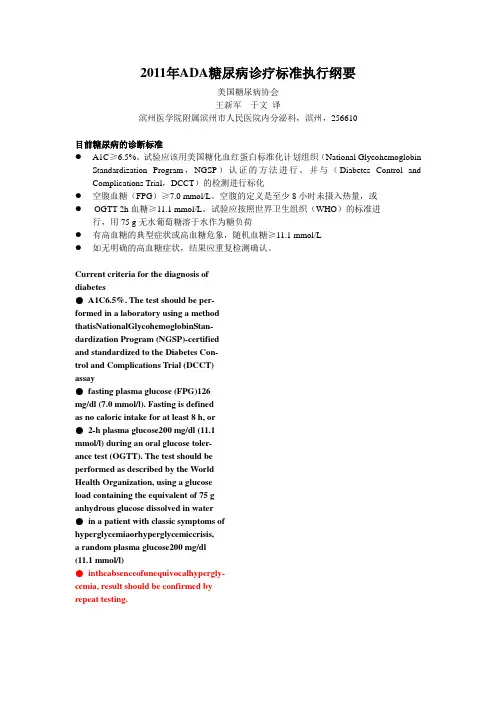
2011年ADA糖尿病诊疗标准执行纲要美国糖尿病协会王新军于文译滨州医学院附属滨州市人民医院内分泌科,滨州,256610目前糖尿病的诊断标准●A1C≥6.5%。
试验应该用美国糖化血红蛋白标准化计划组织(National GlycohemoglobinStandardization Program,NGSP)认证的方法进行。
并与(Diabetes Control and Complications Trial,DCCT)的检测进行标化●空腹血糖(FPG)≥7.0 mmol/L。
空腹的定义是至少8小时未摄入热量,或●OGTT 2h血糖≥11.1 mmol/L。
试验应按照世界卫生组织(WHO)的标准进行,用75 g无水葡萄糖溶于水作为糖负荷●有高血糖的典型症状或高血糖危象,随机血糖≥11.1 mmol/L●如无明确的高血糖症状,结果应重复检测确认。
Current criteria for the diagnosis ofdiabetes●A1C6.5%. The test should be per-formed in a laboratory using a methodthatisNationalGlycohemoglobinStan-dardization Program (NGSP)-certifiedand standardized to the Diabetes Con-trol and Complications T rial (DCCT)assay●fasting plasma glucose (FPG)126mg/dl (7.0 mmol/l). Fasting is definedas no caloric intake for at least 8 h, or●2-h plasma glucose200 mg/dl (11.1mmol/l) during an oral glucose toler-ance test (OGTT). The test should beperformed as described by the WorldHealth Organization, using a glucoseload containing the equivalent of 75 ganhydrous glucose dissolved in water●in a patient with classic symptoms ofhyperglycemiaorhyperglycemiccrisis,a random plasma glucose200 mg/dl(11.1 mmol/l)●intheabsenceofunequivocalhypergly-cemia, result should be confirmed byrepeat testing.在无症状患者中进行糖尿病筛查2)并有一个以上其他糖尿病危险因素(见●在无症状的成人,如超重或肥胖(BMI≥25kg/m“2011年糖尿病诊疗标准”中的表4),应该从任何年龄开始筛查糖尿病并评估将来糖尿病的风险。
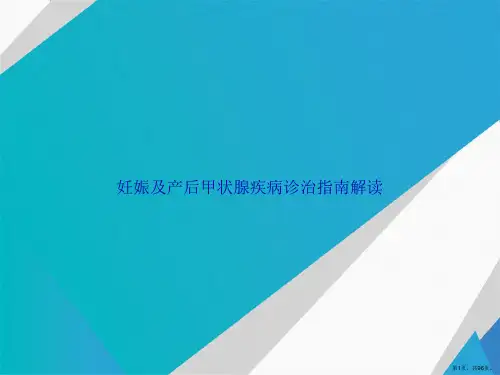
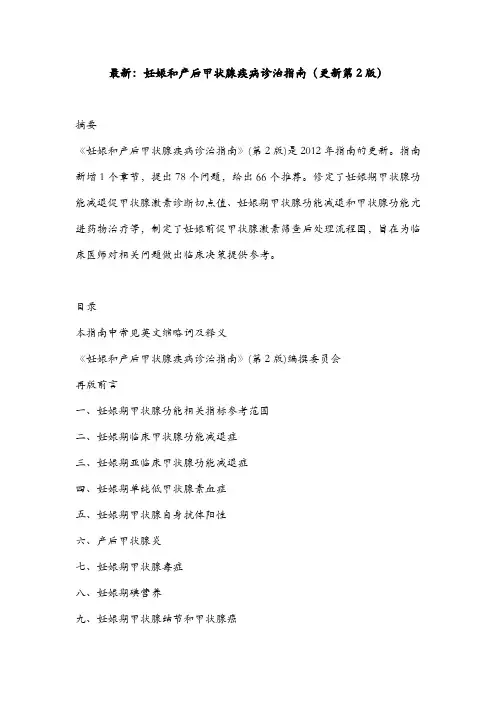
最新:妊娠和产后甲状腺疾病诊治指南(更新第2版)摘要《妊娠和产后甲状腺疾病诊治指南》(第2版)是2012年指南的更新。
指南新增1个章节,提出78个问题,给出66个推荐。
修定了妊娠期甲状腺功能减退促甲状腺激素诊断切点值、妊娠期甲状腺功能减退和甲状腺功能亢进药物治疗等,制定了妊娠前促甲状腺激素筛查后处理流程图,旨在为临床医师对相关问题做出临床决策提供参考。
目录本指南中常见英文缩略词及释义《妊娠和产后甲状腺疾病诊治指南》(第2版)编撰委员会再版前言一、妊娠期甲状腺功能相关指标参考范围二、妊娠期临床甲状腺功能减退症三、妊娠期亚临床甲状腺功能减退症四、妊娠期单纯低甲状腺素血症五、妊娠期甲状腺自身抗体阳性六、产后甲状腺炎七、妊娠期甲状腺毒症八、妊娠期碘营养九、妊娠期甲状腺结节和甲状腺癌十、先天性甲状腺功能减退症十一、妊娠期和妊娠前甲状腺疾病筛查十二、不孕与辅助生殖和甲状腺疾病2012年中华医学会内分泌学分会和中华医学会围产医学分会联合编撰了我国首部《妊娠和产后甲状腺疾病诊治指南》[1]。
当时,采用的是2011年美国甲状腺学会(ATA)妊娠指南问题与推荐的模式,汲取了其精华,同时也突出了中国特色。
妊娠和产后甲状腺疾病是近十年来内分泌学界和围产医学界的热点研究领域之一。
20世纪80年代末期荷兰学者Vulsma等[2]首次发现甲状腺激素合成障碍和无甲状腺新生儿的脐带血中存在甲状腺激素,从而推翻了母体甲状腺激素不能通过胎盘的传统观点。
基础研究证实了母体甲状腺激素在胎儿脑发育前半期(妊娠1~20周)的重要作用,进而引发了多个学科对母体甲状腺激素与胎儿脑发育关系的强烈兴趣。
特别是美国学者Haddow等[3]于20世纪90年代末期关于母体亚临床甲状腺激素缺乏与后代神经智力发育的临床研究结果发表在《新英格兰医学杂志》,使这个领域的研究迅速成为多学科瞩目的热点。
进入21世纪以来,妊娠和产后甲状腺疾病方面的研究急剧增加,十余项大样本的临床试验陆续发表,内分泌学、围产医学、优生学、神经学、儿科学、营养学、地方病学等多个学科参与了这个领域的研究。
Guidelines of the American Thyroid Associationfor the Diagnosis and Management of Thyroid DiseaseDuring Pregnancy and Postpartum美国甲状腺协会妊娠期和产后甲状腺疾病的诊断和治疗指南The American Thyroid Association Taskforce on Thyroid Disease During Pregnancyand Postpartum美国甲状腺协会妊娠期和产后甲状腺疾病特别工作组Translated by Wang Xinjun Binzhou people’s hospital,Binzhou Medical College王新军译滨州医学院附属滨州市人民医院INTRODUCTION前言Pregnancy has a profound impact on the thyroid glandand thyroid function. The gland increases 10% in size during pregnancy in iodine-replete countries and by 20%–40% in areas of iodine deficiency. Production of thyroxine(T4) and triiodothyronine (T3) increases by 50%, along with a 50% increase in the daily iodine requirement. These physiological changes may result in hypothyroidism in the later stages of pregnancy in iodine-deficient women who were euthyroid in the first trimester.妊娠对甲状腺和甲状腺功能具有明显影响。
在点充足地区,妊娠期间甲状腺腺体大小增加10%,在碘缺乏地区,增加约20%~40%。
甲状腺素(T4)和三碘甲状腺原氨酸(T3)增加50%,每天碘需求量增加50%。
这些生理的变化可能导致妊娠前三个月甲状腺功能正常的碘缺乏妇女在妊娠后期发生甲减。
The range of thyrotropin (TSH), under the impact of placental human chorionic gonadotropin (hCG), is decreased throughout pregnancy with the lower normal TSH level in the first trimester being poorly defined and an upper limit of 2.5 mIU/L. Ten percent to 20% of all pregnant women in the first trimester of pregnancy are thyroid peroxidase (TPO) or thyroglobulin (Tg) antibody positive and euthyroid.促甲状腺激素(TSH)的范围在胎盘绒毛膜促性腺激素(hCG)的影响下,在整个妊娠期间均下降,在妊娠前三个月正常低限但尚未充分界定,上限为2.5 MIU/ L。
妊娠前三个月大约10%到20%的妇女甲状腺过氧化物酶(TPO)或甲状腺球蛋白(Tg)抗体阳性且甲状腺功能正常。
Sixteen percent of the women who are euthyroid and positive for TPO or Tg antibody in the first trimester will develop a TSH that exceeds 4.0 mIU/L by the third trimester, and 33%–50% of women who are positive for TPO or Tg antibody in the first trimester will develop postpartum thyroiditis. In essence, pregnancy is a stress test for the thyroid, resulting in hypothyroidism in women with limited thyroidal reserve or iodine deficiency, and postpartum thyroiditis in women with underlying Hashimoto’s disease who were euthyroid prior to conception.妊娠前三个月甲状腺功能正常TPO或TG抗体阳性的妇女中,约16%在妊娠后三个月其促甲状腺激素会超过4.0 mIU/ L,妊娠前三个月TPO或Tg抗体阳性的妇女有33%~50%会发生产后甲状腺炎。
从本质上讲,妊娠是甲状腺的应激试验,在甲状腺功能储备有限或碘缺乏的妇女会发生甲状腺功能减退,而在怀孕前甲状腺功能正常但有潜在桥本甲状腺疾病的妇女会发生产后甲状腺炎。
Knowledge regarding the interaction between the thyroid and pregnancy/the postpartum period is advancing at arapid pace. Only recently has a TSH of 2.5 mIU/L been accepted as the upper limit of normal for TSH in the first trimester. This has important implications in regards to interpretation of the literature as well as a critical impact for the clinical diagnosis of hypothyroidism.关于甲状腺和妊娠/产后期相互作用的只是进展很快。
直到最近,促甲状腺激素2.5 MIU/ L,为怀孕前三个月TSH的正常上限才被接受。
这对于文献的解释及甲状腺功能减退的临床诊断的关键影响具有重要意义。
Although it is well accepted that overt hypothyroidism and overt hyperthyroidism have a deleterious impact on pregnancy, studies are now focusing on the potential impact of subclinical hypothyroidism and subclinical hyperthyroidism on maternal and fetal health, the association between miscarriage and preterm delivery in euthyroid women positive for TPO and/or Tg antibody, and the prevalence andlong-term impact of postpartum thyroiditis. Recently completed prospective randomized studies have begun to produce critically needed data on the impact of treating thyroid disease on the mother, fetus, and the future intellect of the unborn child.虽然显性甲状腺功能减退和显性甲状腺功能亢进症对妊娠具有不利影响已被广泛接受,目前研究集中在亚临床甲状腺功能减退症和亚临床甲状腺功能亢进症对产妇和胎儿健康的潜在影响、在甲状腺功能正常TPO和/或Tg抗体阳性的妇女流产和早产之间的关系,产后甲状腺炎的流行病学和长期影响方面。
最近完成的前瞻性随机研究已经开始给出关于治疗甲状腺疾病对母亲、胎儿的影响,未出生的孩子将来智力的影响方面急需的数据。
It is in this context that the American Thyroid Association (ATA) charged a task force with developing clinical guidelines on the diagnosis and treatment of thyroid disease during pregnancy and the postpartum. The task force consisted of international experts in the field of thyroid disease and pregnancy, and included representatives from the ATA, Asia and Oceania Thyroid Association, Latin American Thyroid Society, American College of Obstetricians and Gynecologists, and the Midwives Alliance of North America. Inclusion of thyroidologists, obstetricians, and midwives on the task force was essential to ensuring widespread acceptance and adoption of the developed guidelines.正是在这种背景下,美国甲状腺协会(ATA)成立了一个特别工作组负责制定妊娠和产后甲状腺疾病诊断和治疗的临床指南。
特别工作组由甲状腺疾病和妊娠领域的国际专家、ATA的代表、亚洲和大洋洲甲状腺协会的代表、拉丁美洲甲状腺协会的代表、美国妇产科学院的代表和北美助产士联盟的代表组成。